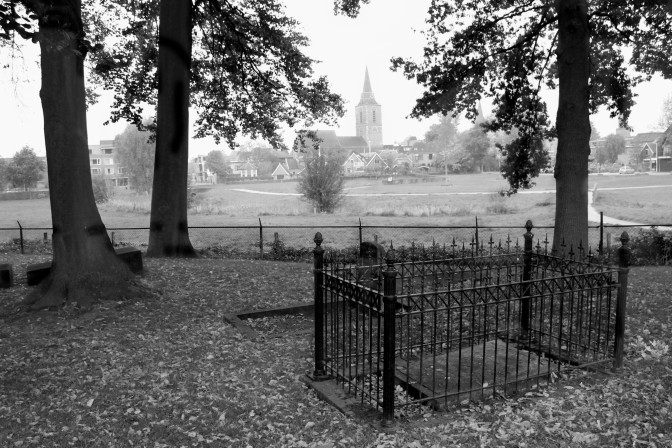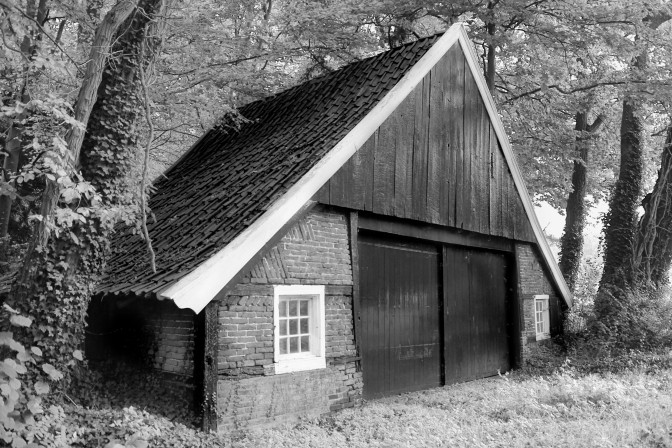My father’s family is from a small village in the Netherlands called Winterswijk. All 2,000+ ancestors of his that I’ve been able to trace so far were from Winterswijk or the immediate surroundings. People first started living in that area in the early Middle Ages and I would not be surprised to find out that most of my paternal ancestors descend from that initial group of Saxons who settled there.

Cemetery in Winterswijk. Photo by author.
‘Kissing cousins’ turn into a one-place-study
When I started researching my ancestors, I quickly discovered that my grandparents shared several different ancestors. Marriages between distant cousins were common in a place where no newcomers ever settled. Like my grandparents, who were seventh cousins several times over, most people who got married did not know they were related. I soon realized that everybody was related to everybody.
To understand the family dynamics and solve my brick walls, my family research quickly turned into a one-place-study. As part of my one-place-study, I am trying to find out what happened to the more than six thousand emigrants who emigrated from Winterswijk and the surrounding area. So far, I’ve been able to find over four thousand of them in US records. If you’re interested in the research, my tree is available on this site and at Ancestry.com.
DNA matches descendants of emigrants
Out of scientific curiosity, and in the hope of solving some brick walls on my mother’s side, I took autosomal DNA tests with the three major companies (23andMe, Ancestry.com and FamilyTreeDNA). These tests analyze the 22 pairs of non-sex chromosomes and compare them to the other people who have already taken a test. The companies provide a list of DNA matches, people whose DNA matches yours. The more DNA you have in common, the closer the relationship.
I never thought the test would be helpful for my father’s side, since I had managed to trace all of his ancestors back ten generations. But it was!
Among my DNA matches, I soon discovered dozens of American descendants of the emigrants I’m tracing. Most of their immigrant ancestors settled in places I was familiar with, like Clymer in New York and Sheboygan county in Wisconsin. Hundreds of Winterswijkers settled in these locations.
But some Winterswijk ancestors of my DNA matches were in places where I had never thought to look; in small towns in Minnesota, South Dakota and Massachusetts, off the beaten track. Some of their names were changed almost beyond recognition but the DNA evidence made me look hard and see who was hiding underneath the new name.
Emigrants often wrote letters home, urging people to come over, so where there’s one Winterswijker, you’ll often find several. By checking the census records for the places where I found an emigrant through DNA, I managed to find several more.
One reason this probably works so well for me is the high level of endogamy in Winterswijk. The same bits of DNA have been tossed around for centuries, making relationships look closer than they are. Those shared bits of Winterswijk DNA can show up in very distant cousins. What the testing companies predict to be a 4th cousin may well turn out to be an 8th cousin four times over.
Finding out which ancestor contributed the shared DNA is a headache, since I share multiple ancestors with most of my cousins. But that doesn’t matter for my one-place-study. The DNA test puts me in touch with distant cousins and allows me to find out new places where Winterswijkers settled after emigration. What a great new tool for my one-place-study!

Shed in Winterswijk. Photo by author.


I have been thinking about doing this kind of thing. But the marriages with people from the neighboring towns makes it hard to even plan as a project.
How rigid are your town borders? Not the geographic town, of course, but the sociological town? How often did people 100-150 years ago mattry out-of-towners and how far away? (I mean these as rhetorical questions, I think.)
Dag Yvette,
De laatste tijd ben ik me gaan verdiepen in de geschiedenis van Winterswijk en ontdekte wat jij al lang wist, namelijk dat er heel veel zij geëmigreerd naar de USA.
Op zoek naar het waarom zoveel stierven op Lake Michigan 21 november 1847, stuitte ik bij toeval op jouw website. Leuk zeg!
Ik heb zelf helemaal geen roots met Winterswijk, ik woon er alleen en ben de omgekeerde weg gaan bewandelen. De oudst bekende archieven op MyHeritage gaan invullen en links zoeken.
Ik zal nog regelmatig van je gegevens gebruik maken.
Succes met je werkzaamheden.
Vriendelijke groet,
Arno Been
I wish I could offer my atDNA matches as help. I have two 4th cousins from Winterswijkian ancestors, but not in any unusual place. One is a Schoemaker from Muscatine, and the other is a Huinink from Clymer.